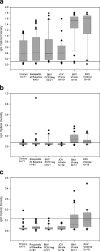Immunoglobulin G, A, and M responses to BK virus in renal transplantation
- PMID: 16960119
- PMCID: PMC1563576
- DOI: 10.1128/CVI.00114-06
Immunoglobulin G, A, and M responses to BK virus in renal transplantation
Abstract
Immunoglobulin G (IgG), IgA, and IgM antibodies were measured in serum samples from 71 organ donors, 81 kidney transplant recipients at transplantation, and 67 patients during the posttransplant period by using a virus-like particle-based enzyme-linked immunosorbent assay (ELISA). BK virus (BKV) and JC virus DNA were detected in urine and plasma by real-time PCR. IgG antibodies to BKV were demonstrated in the majority (80.3 to 100%) of patients irrespective of clinical category, but titers were highest in patients with active viral replication. IgA antibodies were present with greater frequency (72.7 to 81.3% versus 0 to 23.6%; P < 0.001) and higher titer (mean optical density, 0.11 to 0.15 versus 0.05 to 0.08; P < 0.001) in patients who were BKV DNA positive than those who were BKV DNA negative. IgM antibodies showed a similar pattern of reactivity but lower frequency in the setting of active viral replication (9.1 to 43.7% versus 0 to 1.4%; P < 0.001). A rise in IgG level of >0.577 optical density (OD) units or a rise in IgA or IgM level of >0.041 OD units was strongly associated with active viral replication. Urine viral load showed a positive correlation with IgM titer (r = 0.22) but a negative correlation with IgG titer (r = -0.28) and IgA titer (r = -0.1). Chronic dialysis patients typically did not have serologic or virologic evidence of active BKV infection. Anti-BKV titers did not rise in patients with JC viruria. In conclusion, measurement of anti-BKV antibody titer and class response can be used to detect the onset of viral replication. ELISAs can be quite specific despite considerable sequence homology between BK virus and JC virus.
Figures



Similar articles
-
longitudinal analysis of levels of immunoglobulins against BK virus capsid proteins in kidney transplant recipients.Clin Vaccine Immunol. 2008 Oct;15(10):1564-71. doi: 10.1128/CVI.00206-08. Epub 2008 Aug 27. Clin Vaccine Immunol. 2008. PMID: 18753339 Free PMC article.
-
Sustained BK viruria as an early marker for the development of BKV-associated nephropathy: analysis of 4128 urine and serum samples.Transplantation. 2009 Jul 15;88(1):89-95. doi: 10.1097/TP.0b013e3181aa8f62. Transplantation. 2009. PMID: 19584686
-
BK virus antibody titers and intensity of infections after renal transplantation.J Clin Virol. 2008 Oct;43(2):184-9. doi: 10.1016/j.jcv.2008.06.009. Epub 2008 Aug 3. J Clin Virol. 2008. PMID: 18676176 Free PMC article. Clinical Trial.
-
Neutralizing Antibody-Mediated Response and Risk of BK Virus-Associated Nephropathy.J Am Soc Nephrol. 2018 Jan;29(1):326-334. doi: 10.1681/ASN.2017050532. Epub 2017 Oct 17. J Am Soc Nephrol. 2018. PMID: 29042457 Free PMC article.
-
BK virus nephritis after renal transplantation.Kidney Int. 2006 Feb;69(4):655-62. doi: 10.1038/sj.ki.5000040. Kidney Int. 2006. PMID: 16395271 Review.
Cited by
-
Pre-transplant immune factors may be associated with BK polyomavirus reactivation in kidney transplant recipients.PLoS One. 2017 May 31;12(5):e0177339. doi: 10.1371/journal.pone.0177339. eCollection 2017. PLoS One. 2017. PMID: 28562595 Free PMC article.
-
Polyclonal gammopathy after BKV infection in HSCT recipient: a novel trigger for plasma cells replication?Virol J. 2015 Feb 13;12:23. doi: 10.1186/s12985-015-0254-z. Virol J. 2015. PMID: 25886491 Free PMC article.
-
The polyomavirus BK large T-antigen-derived peptide elicits an HLA-DR promiscuous and polyfunctional CD4+ T-cell response.Clin Vaccine Immunol. 2011 May;18(5):815-24. doi: 10.1128/CVI.00487-10. Epub 2011 Mar 2. Clin Vaccine Immunol. 2011. PMID: 21367979 Free PMC article.
-
BK Polyomavirus: Clinical Aspects, Immune Regulation, and Emerging Therapies.Clin Microbiol Rev. 2017 Apr;30(2):503-528. doi: 10.1128/CMR.00074-16. Clin Microbiol Rev. 2017. PMID: 28298471 Free PMC article. Review.
-
Human polyomavirus type 1 (BK virus) agnoprotein is abundantly expressed but immunologically ignored.Clin Vaccine Immunol. 2007 Aug;14(8):959-68. doi: 10.1128/CVI.00123-07. Epub 2007 May 30. Clin Vaccine Immunol. 2007. PMID: 17538118 Free PMC article.
References
-
- Bodeus, M., F. Smets, R. Reding, E. Sokal, J. B. Otte, P. Goubau, and L. van Renterghem. 1999. Epstein-Barr virus infection in sixty pediatric liver graft recipients: diagnosis of primary infection and virologic follow-up. Pediatr. Infect. Dis. J. 18:698-702. - PubMed
-
- Bohl, D. L., G. Storch, C. Ryschkewitsch, M. Gaudreault-Keener, M. Schnitzler, E. O. Major, and D. C. Brennan. 2005. Donor origin of BK virus in renal transplantation and role of HLA C7 in susceptibility to sustained BK viremia. Am. J. Transplant. 5:2213-2221. - PubMed
-
- Bohl, D. L., C. Ryschkewitsch, E. O. Major, G. A. Storch, and D. C. Brennan. 2005. BK virus antibody titers markedly increase with viremia. Am. J. Transplant. 5(Suppl. 11):273A.
-
- Chang, D., M. Wang, W. C. Ou, M. S. Lee, H. N. Ho, and R. T. Tsai. 1996. Genotypes of human polyomaviruses in urine samples of pregnant women in Taiwan. J. Med. Virol. 48:95-101. - PubMed
Publication types
MeSH terms
Substances
Grants and funding
LinkOut - more resources
Full Text Sources
Other Literature Sources
Medical
Miscellaneous

